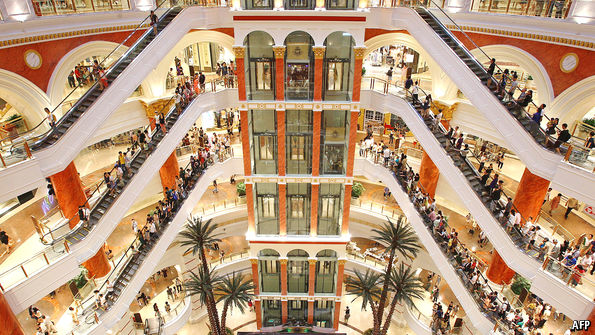by Xian Wan and Biodun Iginla, political news analysts, The Economist Intelligence Unit, Shanghai
Doughty but not superhuman
China’s consumption boom is not enough to succour the world economy

Global Harbor (pictured) ranks among the world’s biggest shopping malls, its floor space equivalent to nearly 70 football fields. It blends ersatz European architecture with a distinctly Asian selection of stores. Beneath its vaulting glass domes and mock renaissance murals are a Hello Kitty café, a half-dozen noodle restaurants, jewellery shops dripping with gold and a theatre used for karaoke contests.
It is only a slight exaggeration to say that China’s economic hopes rest on the faux-Corinthian columns of Global Harbor. With the country’s decades-old investment boom fast dwindling, it needs consumption to kick in as a new driver of growth. This rebalancing has been talked about for years, but has become more urgent as China’s industrial downturn has deepened. The nationwide frenzy of construction is abating, factories are saddled with overcapacity and the northern rustbelt is on the brink of recession. This week a manufacturing index recorded its lowest monthly reading in six years, and the seventh successive contraction.
Amid the extreme pessimism about China’s economy in recent months, it is tempting to conclude that rebalancing has failed. Just look at the car market, usually a good shorthand for the health of consumer demand. Automobile sales fell by 3.4% in August compared with a year ago, the third monthly decline in a row. Yet other forms of consumption are accelerating. A property recovery has stoked demand for furniture, home electronics and renovation materials, with sales rising an average of 17% in August from a year earlier. From jewellery to traditional Chinese medicine, buying has picked up in recent months.
Smartphone sales are down in volume terms but soaring by value, as shoppers move upmarket. Companies hit by the anti-corruption campaign under Xi Jinping, China’s president, are learning to prosper despite the new strictures. Distillers’ profits, which fell last year, have rebounded, pulled along by affordable brands for ordinary consumers rather than the exorbitantly priced bottles previously used as bribes for officials.
Overall, China’s retail sales have increased by 10.5% in real terms this year, well ahead of economic growth (officially 7% but closer to 6% according to many analysts). There are, as ever, doubts about the reliability of China’s data, though in this case it may be that the retail figures are too low. Nicholas Lardy, an expert on Chinese statistics at the Peterson Institute for International Economics, a think-tank, notes that retail numbers do not include services, a glaring omission since surveys show that services account for as much as two-fifths of China’s consumer spending.
All this suggests that consumption is picking up at least some of the slack from the industrial downturn. The main reason for the resilience of the Chinese shopper is steady income growth. Wages for migrant workers rose by 10% in the second quarter compared with a year earlier, faster than the national average of 7%. Since low-income earners tend to spend more of their pay than the rich, that has given consumption an extra boost.
One concern is whether this income growth can continue as Chinese industry struggles. Some factories are cutting jobs. But services account for a bigger share of the economy than industry, employ more people and are still growing well.
Structural factors are also at work. With China’s working-age population now shrinking, labour is becoming scarcer and employees command higher wages. China’s household savings rate of nearly 30%, among the world’s highest, is also beginning to fall as the population ages and the elderly draw down some of their accumulated wealth. Household consumption as a share of GDP fell to 35.9% in 2010, unusually low even by Asian standards, but has since been clawing its way up.
A generational shift has helped. For older Chinese, the experience of deprivation in Mao’s day inhibits spending. At Global Harbor on a Sunday afternoon, those carrying shopping bags or queuing up at restaurants are overwhelmingly in their 20s and 30s. “Our parents are very careful but we want to have more of a balance in life,” says Lulu Yu. A legal assistant out with her boyfriend to watch a film, she is the picture of a fully grown consumer. Sporting fashionably tinted hair and contact lenses to make her eyes appear bigger, she dangles new high heels from her arm, an impulse purchase on the way to the cinema.
Does this mean that Chinese shoppers are poised to become an engine of the world economy, like their fabled American counterparts? In some ways this has already happened. The number of Chinese tourists going abroad rose by 19.5% last year to 107m. What’s more, Chinese tourists spend more than others, snapping up goods that are cheaper abroad. All this makes China the world’s biggest source of tourism dollars (see chart). In South Korea and Thailand, the increase in spending by Chinese tourists in 2011-14 made up for the fall in exports to China over the same period, according to Capital Economics, a research firm.

This relative self-reliance is likely to increase with time. A study by Bain, a consultancy, found that out of 26 categories of cheap consumer goods, foreign brands lost market share in 18 last year, including skin cream, milk, fabric softener and toothpaste. In more sophisticated products, domestic companies are also elbowing into territory once dominated by international players. Chinese car brands have accounted for 41% of sales this year, a 3.5 percentage-point increase in market share. Growing consumption of services, whether cosmetic surgery or restaurant meals, only accentuates the home advantage, since most services are delivered locally. China’s consumer boom is real. But do not count on it to lift the global economy.

No comments:
Post a Comment